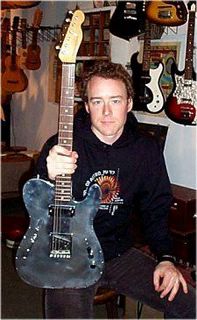Late last month, Sparhawk did a nutty little interview with Pitchfork, which eloquently repeated his “Here’s how crazy I got:” story, along with a bizarre Mormon + Pot = bass player leaving story. Like a hockey crowd looking for a fight on the ice, there were lots of us there that understood a minor meltdown may be afoot if the crazy stars aligned themselves just right.
Sidenote
I’m so fucking angry at myself that I spelled “there” in the last sentence as “their” and spellcheck caught it before me. Stupid Stupid Stupid. I feel like such a retard right now.
End Sidenote
Having seen Low before several years ago, I knew that drinking a lot of High Life may create a sleep coma when mixed with Low’s “slowcore” tempos. But Sparhawk has wisely implemented some expansion efforts in his material as their music developed a bigger arrangement on the past three albums. Fine, then. I’ll stop at three High Lifes.
The polite audience sat down, hippie style, in front of the stage. Luckily, our seats were positioned directly off stage left, with new bassist Matt Livingston’s scrawny ass just four feet away from my face. A few things about Matt Livingston:
1.) He’s got a very scrawny little ass
2.) He needs to pull up his pants
3.) The elastic band on his boxers is showing
It was a very informal performance, with stripped down renditions of their last three albums taking up the majority of the set list. One song was aborted momentarily, after Sparhawk realized mid-verse that they’d begun in a higher key than he could sing in. Livingston and Mimi Parker kept going while Alan lowered the strings after asking permission from his invisible friend, Dr. Minnetonka. He then pulled out an apricot and yelled “Stop looking at me!” at the audience.
Alan then tried to kill himself by adjusting the stage lights in front of him despite being electrocuted doing the same thing once before.
His wife, Mimi Parker, occasionally ribbed him by telling him that he had “too many gadgets” for his guitar and other hurtful comments. Alan started weeping uncontrollably until a roadie came up and offered a huge joint that would take him directly to his “happy place.”
Mimi’s kit remains as primitive as ever, and Alan spent the majority of the night behind an acoustic guitar (with a bunch of guitar-effect pedals) carefully channeling an almost morbid muse. The other thing that remains with her presence is the unbelievable harmonies she adds. This is critical. With Low, things move at a snails pace, requiring listeners to be attentive to every detail. Mimi’s voice adds a very ethereal element to a very dirge-like rhythm. It’s clear that Low wouldn’t have been able to sustain an over decade long history without her contribution.

A girl that looked an awful lot like Harry Potter yelled out “Sunflower” when they came back for an encore. They started playing it (most awesomely, I might add) and then the Harry Potter girl scream “Yes!”, clapped her hands together and then pissed her pants
The “hit” “When I Go Deaf” ended the three song encore in a swell of feedbacks until Alan finally declared “I think we’re done now.”
Three other interesting things about new bass player Matt Livingston:
1.) His second touring bass is one of those Steinberger ones
2.) He wears glasses
3.) He’s a pretty nice guy
“When they finally found your body/Giant x’s on your eyes” starts the uplifting “Sunflower.” I suppose I’m a little grateful that they didn’t find Alan at the end of a noose. I’m glad he’s apparently gotten his shit just a little bit together. And, considering how his child with Mimi is probably ready for kindergarten and how touring may not be a viable option soon, I’m glad I took a night off see Low on their “Crazy From The Weed” tour.
Setlist:
Dragonfly
Monkey
Sandanista
In The Drugs
California
Amazing Grace
Condescend
Pissing
Violent Past
Lazy
Murder
Encore
Over The Ocean
Sunflower
When I Go Deaf


